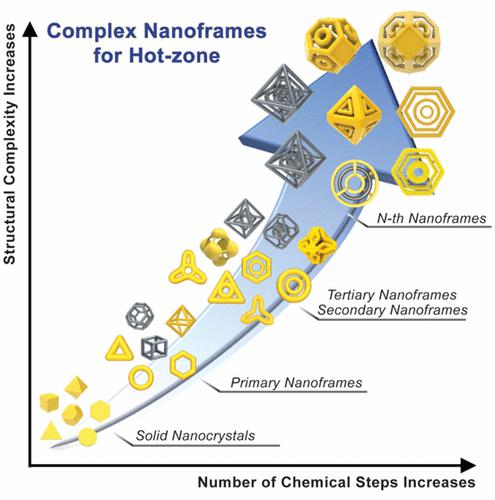当前位置:
X-MOL 学术
›
Acc. Chem. Res.
›
论文详情
Our official English website, www.x-mol.net, welcomes your
feedback! (Note: you will need to create a separate account there.)
Multiple Stepwise Synthetic Pathways toward Complex Plasmonic 2D and 3D Nanoframes for Generation of Electromagnetic Hot Zones in a Single Entity
Accounts of Chemical Research ( IF 16.4 ) Pub Date : 2023-01-24 , DOI: 10.1021/acs.accounts.2c00670 Insub Jung 1, 2 , Jeongwon Kim 1 , Sungwoo Lee 1, 2 , Woocheol Park 1 , Sungho Park 1
Accounts of Chemical Research ( IF 16.4 ) Pub Date : 2023-01-24 , DOI: 10.1021/acs.accounts.2c00670 Insub Jung 1, 2 , Jeongwon Kim 1 , Sungwoo Lee 1, 2 , Woocheol Park 1 , Sungho Park 1
Affiliation

|
Rational design of nanocrystals with high controllability via wet chemistry is of critical importance in all areas of nanoscience and nanotechnology research. Specifically, morphologically complex plasmonic nanoparticles have received considerable attention because light–matter interactions are strongly associated with the size and shape of nanoparticles. Among many types of nanostructures, plasmonic nanoframes (NFs) with controllable structural intricacy could be excellent candidates as strong light-entrappers with inner voids as well as high surface area, leading to highly effective interaction with light and analytes compared to their solid counterparts. However, so far studies on single-rim-based NFs have suffered from insufficient near-field focusing capability due to their structural simplicity (e.g., a single rim or NF molded from simple platonic solids), which necessitates a conceptually new NF architecture. If one considers a stereoscopic nanostructure with dual, triple, and multiple resonant intra-nanogaps on each crystallographic facet of nanocrystals, unprecedented physicochemical properties could be expected. Realizing such complex multiple NFs with intraparticle surface plasmon coupling via localized surface plasmon resonance is very challenging due to the lack of synthetic strategic principles with systematic structural control, all of which require a deep understanding of surface chemistry. Moreover, realizing those complex architectures with high homogeneity in size and shape via a bottom-up method where diverse particle interactions are involved is more challenging. Although there have been several reports on NFs used for catalysis, techniques for production of structurally complex NFs with high uniformity and an understanding of the correlation between such complexity in a single plasmonic entity and electromagnetic near-field focusing have remained highly elusive.
中文翻译:

用于在单个实体中生成电磁热区的复杂等离子体 2D 和 3D 纳米框架的多步合成途径
通过湿化学合理设计具有高可控性的纳米晶体在纳米科学和纳米技术研究的所有领域都至关重要。具体来说,形态复杂的等离子体纳米粒子受到了相当大的关注,因为光-物质相互作用与纳米粒子的大小和形状密切相关。在许多类型的纳米结构中,具有可控结构复杂性的等离激元纳米框架 (NFs) 可以作为具有内部空隙和高表面积的强光捕获剂,与固体对应物相比,可以与光和分析物进行高效的相互作用。然而,到目前为止,由于结构简单(例如,单个轮辋或由简单的柏拉图式固体模制而成的 NF),这需要一个概念上新的 NF 架构。如果考虑在纳米晶体的每个晶体学面上具有双重、三重和多重共振纳米间隙的立体纳米结构,则可以预期前所未有的物理化学性质。由于缺乏具有系统结构控制的合成战略原则,通过局部表面等离子体共振实现具有粒子内表面等离子体激元耦合的复杂多重 NF 非常具有挑战性,所有这些都需要对表面化学有深入的了解。此外,通过涉及不同粒子相互作用的自下而上的方法实现那些尺寸和形状高度均匀的复杂架构更具挑战性。尽管有几篇关于 NFs 用于催化的报道,
更新日期:2023-01-24
中文翻译:

用于在单个实体中生成电磁热区的复杂等离子体 2D 和 3D 纳米框架的多步合成途径
通过湿化学合理设计具有高可控性的纳米晶体在纳米科学和纳米技术研究的所有领域都至关重要。具体来说,形态复杂的等离子体纳米粒子受到了相当大的关注,因为光-物质相互作用与纳米粒子的大小和形状密切相关。在许多类型的纳米结构中,具有可控结构复杂性的等离激元纳米框架 (NFs) 可以作为具有内部空隙和高表面积的强光捕获剂,与固体对应物相比,可以与光和分析物进行高效的相互作用。然而,到目前为止,由于结构简单(例如,单个轮辋或由简单的柏拉图式固体模制而成的 NF),这需要一个概念上新的 NF 架构。如果考虑在纳米晶体的每个晶体学面上具有双重、三重和多重共振纳米间隙的立体纳米结构,则可以预期前所未有的物理化学性质。由于缺乏具有系统结构控制的合成战略原则,通过局部表面等离子体共振实现具有粒子内表面等离子体激元耦合的复杂多重 NF 非常具有挑战性,所有这些都需要对表面化学有深入的了解。此外,通过涉及不同粒子相互作用的自下而上的方法实现那些尺寸和形状高度均匀的复杂架构更具挑战性。尽管有几篇关于 NFs 用于催化的报道,











































 京公网安备 11010802027423号
京公网安备 11010802027423号